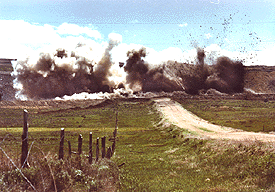
|
- The rate of detonation can be as high as four miles per
second.
- A shock wave may be followed by combustion because the gases
produced are flammable.
- Primary high explosives may be detonated by shock, heat, or
friction producing a detonative wave in an extremely short period of time. Examples are:
lead azide, mercury fulminate, and lead styphnate.
- Secondary high explosives generally need a booster to cause
detonation. They are relatively insensitive to shock, heat, or friction. Examples are:
Tetryl, cyclonite, dynamite, and TNT.
|